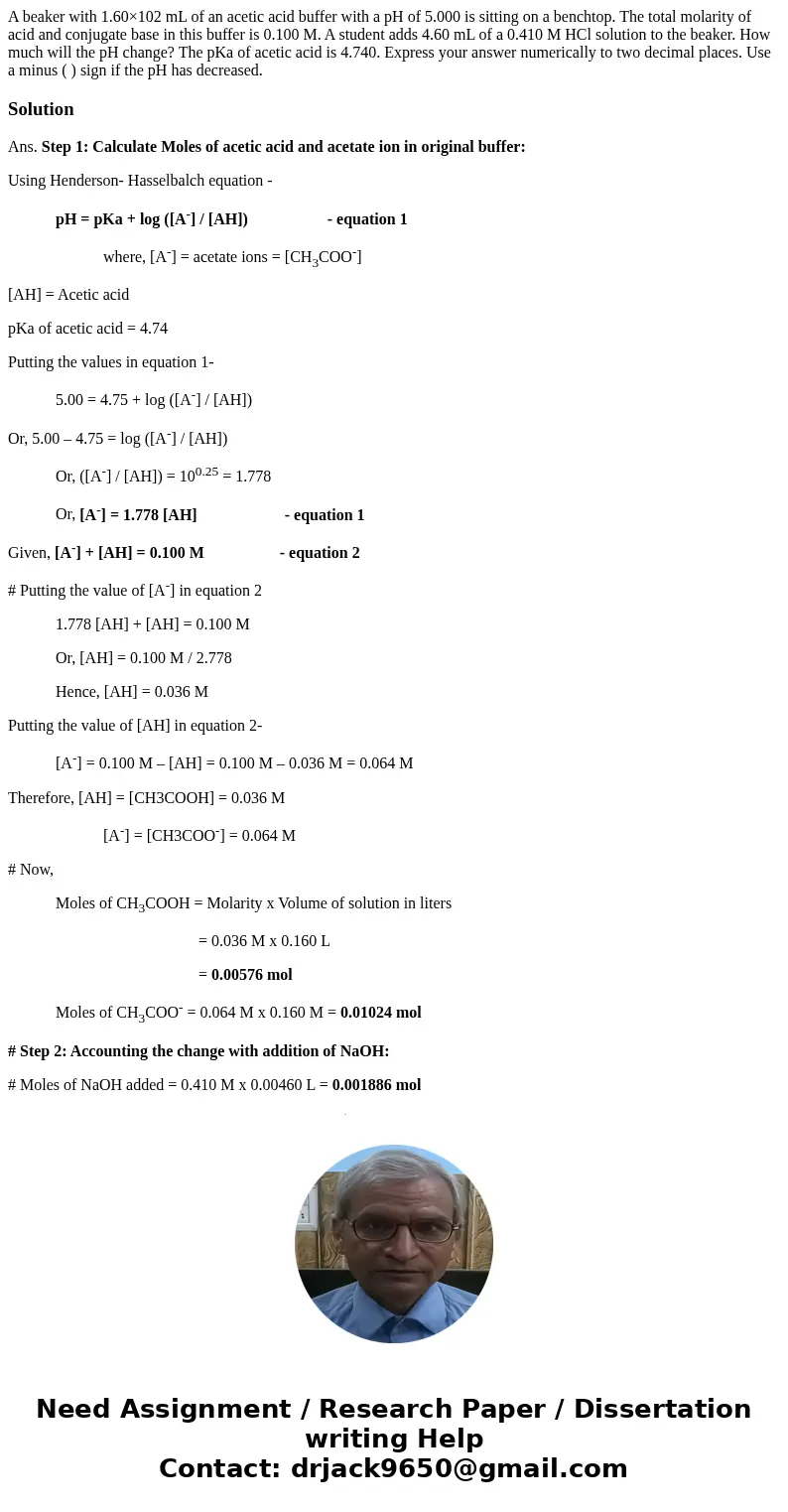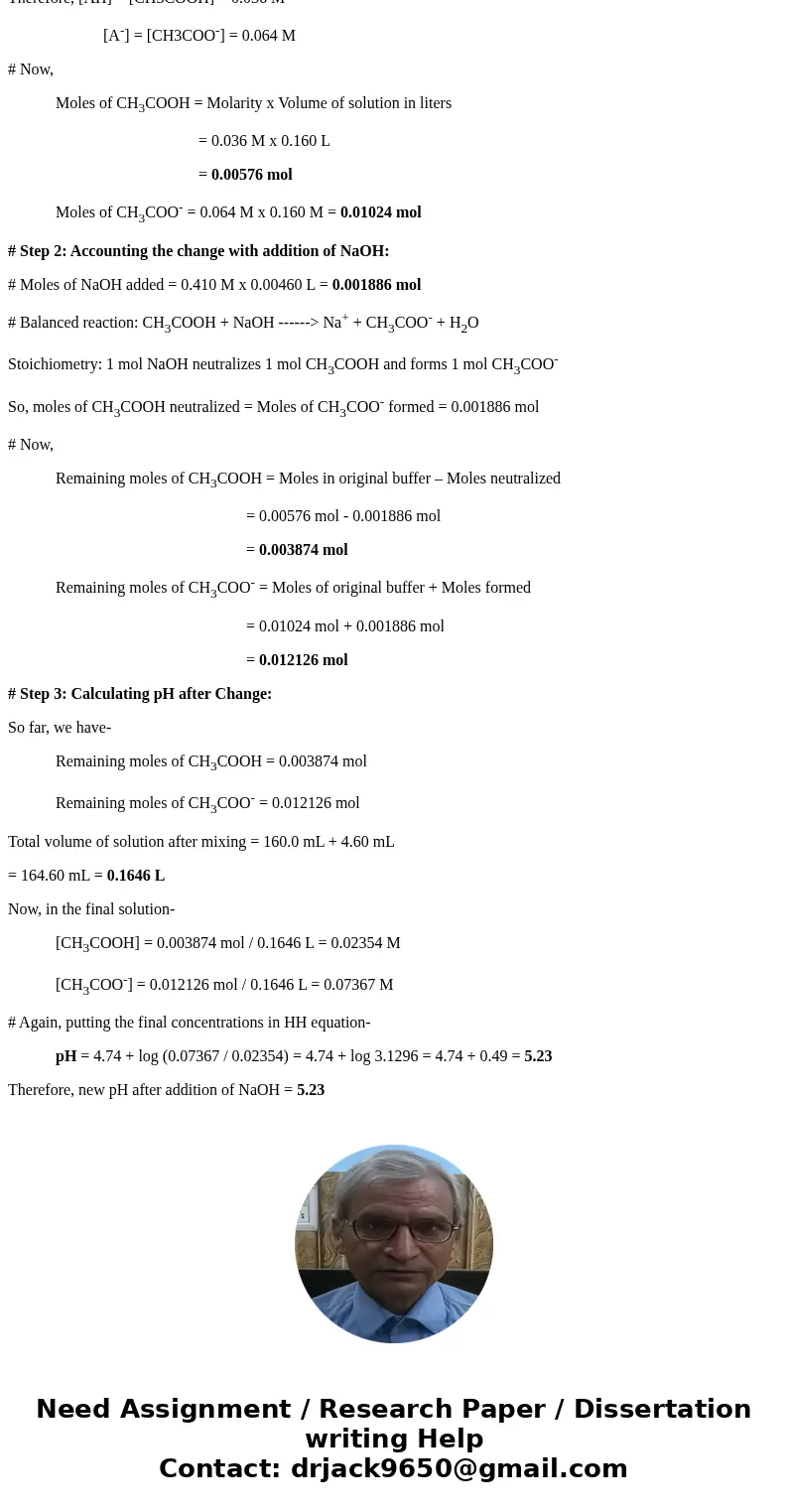A beaker with 160102 mL of an acetic acid buffer with a pH o
A beaker with 1.60×102 mL of an acetic acid buffer with a pH of 5.000 is sitting on a benchtop. The total molarity of acid and conjugate base in this buffer is 0.100 M. A student adds 4.60 mL of a 0.410 M HCl solution to the beaker. How much will the pH change? The pKa of acetic acid is 4.740. Express your answer numerically to two decimal places. Use a minus ( ) sign if the pH has decreased.
Solution
Ans. Step 1: Calculate Moles of acetic acid and acetate ion in original buffer:
Using Henderson- Hasselbalch equation -
pH = pKa + log ([A-] / [AH]) - equation 1
where, [A-] = acetate ions = [CH3COO-]
[AH] = Acetic acid
pKa of acetic acid = 4.74
Putting the values in equation 1-
5.00 = 4.75 + log ([A-] / [AH])
Or, 5.00 – 4.75 = log ([A-] / [AH])
Or, ([A-] / [AH]) = 100.25 = 1.778
Or, [A-] = 1.778 [AH] - equation 1
Given, [A-] + [AH] = 0.100 M - equation 2
# Putting the value of [A-] in equation 2
1.778 [AH] + [AH] = 0.100 M
Or, [AH] = 0.100 M / 2.778
Hence, [AH] = 0.036 M
Putting the value of [AH] in equation 2-
[A-] = 0.100 M – [AH] = 0.100 M – 0.036 M = 0.064 M
Therefore, [AH] = [CH3COOH] = 0.036 M
[A-] = [CH3COO-] = 0.064 M
# Now,
Moles of CH3COOH = Molarity x Volume of solution in liters
= 0.036 M x 0.160 L
= 0.00576 mol
Moles of CH3COO- = 0.064 M x 0.160 M = 0.01024 mol
# Step 2: Accounting the change with addition of NaOH:
# Moles of NaOH added = 0.410 M x 0.00460 L = 0.001886 mol
# Balanced reaction: CH3COOH + NaOH ------> Na+ + CH3COO- + H2O
Stoichiometry: 1 mol NaOH neutralizes 1 mol CH3COOH and forms 1 mol CH3COO-
So, moles of CH3COOH neutralized = Moles of CH3COO- formed = 0.001886 mol
# Now,
Remaining moles of CH3COOH = Moles in original buffer – Moles neutralized
= 0.00576 mol - 0.001886 mol
= 0.003874 mol
Remaining moles of CH3COO- = Moles of original buffer + Moles formed
= 0.01024 mol + 0.001886 mol
= 0.012126 mol
# Step 3: Calculating pH after Change:
So far, we have-
Remaining moles of CH3COOH = 0.003874 mol
Remaining moles of CH3COO- = 0.012126 mol
Total volume of solution after mixing = 160.0 mL + 4.60 mL
= 164.60 mL = 0.1646 L
Now, in the final solution-
[CH3COOH] = 0.003874 mol / 0.1646 L = 0.02354 M
[CH3COO-] = 0.012126 mol / 0.1646 L = 0.07367 M
# Again, putting the final concentrations in HH equation-
pH = 4.74 + log (0.07367 / 0.02354) = 4.74 + log 3.1296 = 4.74 + 0.49 = 5.23
Therefore, new pH after addition of NaOH = 5.23


 Homework Sourse
Homework Sourse